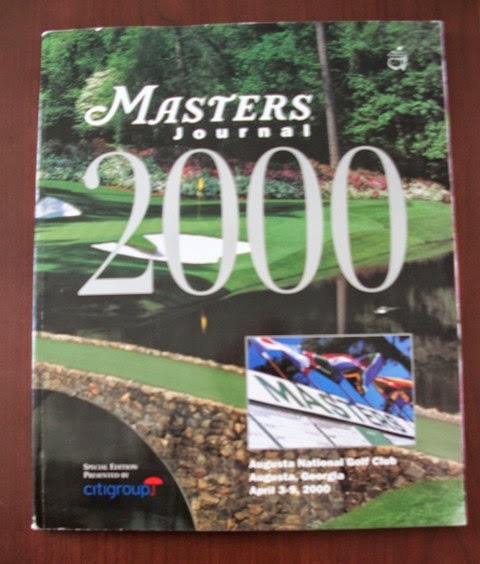Let me begin this article with an admission: I am
not an avid sports fan. Certainly, I’ll check in on the Super Bowl, the World
Series, and the Olympics (though Sochi was the first Olympic Games that I
actively avoided), and I’ll take in the awe and spectacle, but afterwards, it’s
all just a game to me.
The same applies to the Masters, which is, in a
word, the World Cup of golf. I bought this journal not because I follow golf,
but because 1) it’s a Year 2000 item, and 2) that year, the Masters opened on
my birthday (April 3rd). It came from the St. Vincent de Paul Thrift
Store in Midlothian, IL, where I've found one or two very good Millennium Artifacts in the past
year.
(Oh, just as a heads-up, the Masters Tournament will start next Monday.)
…So, the Masters 2000 Journal. At the time,
Citibank (or Citigroup, as it was known) provided backing for the tournament,
and there are one or two ads for the corporation. At the time, Citibank had
just bought Travelers Insurance and undergone a huge rebranding effort. Gone
were the days of the italicized, all-caps “CITIBANK” logo—gone were the days of
“CITIBANK,” actually—this marked the age of “CITI” and “CITIGROUP” in a simple,
all lower-case font. Also, the red Travelers umbrella appeared at the end of
the word “Citigroup;” it’s now a stylized red arc that sits on top of the “t”
and covers the two “i’s.”
Enough about banking and financing; what about the
rest of the book? It fits the “time capsule” mandate of the Millennium Museum
quite well. It starts out with a five-page section about the Masters’ humble
beginnings, and after that there’s a decade-by-decade “potted history,” which
recaps each year’s tournament, tells us who won that year, and offers up a few
interesting highlights. For example, in 1997, a 21-year-old Tiger Woods became
the youngest winner in Masters’ history.
The entry says, “…Tiger Woods re-wrote [sic] a good portion of the tournament’s
record book. His 270 total and 12-stroke margin of victory were two of 20
records the 21-year-old established. His play in Amen Corner—seven under par
for the four rounds—was instrumental in his becoming the youngest Masters
champion” (Masters 25).
The book only goes up to 1999—I assume this is
because it was released well before the 2000 edition had even begun. The winner
that year was Spain’s Jose Maria Olazabal, who had previously won the British
Boys’ tournament; the British Amateur Championship; the British Youths’
tournaments; and the 1994 Masters (Masters 44). Few people knew at the time
that Olazabal was playing through a foot ailment that first started in 1993,
and after he won in ’94, it got so bad that he needed surgery.
By 1995, he was almost completely debilitated.
In 1997, he sought the help of a Munich-based
specialist, who diagnosed him with “nerve pressure in his lower back that was
affecting muscles in his feet” (44), and so began his recovery. Though he was
always humble, Olazabal’s illness put everything into a new perspective: “After
what I have been through, golf gives me a different feeling, a
determination…I’ve had the chance to have the best cars and to be able to build
a house with enough room to bring my parents to live there with me. I am paying
them back. That is what I enjoy, to see them happy” (45).
The next section of the book is a play-by-play
dissection of the course. Each of the eighteen holes takes its name from a
flower (Holly, Azalea, etc.), and each has its own difficulty grade. You may
recall a passing reference to something called “Amen Corner” earlier, and now
is a good time to explain what that is—in fact, the section opens with “Prayers
at the Heart of Amen Corner.”
Though it’s officially named Golden Bell, the
twelfth hole on the course has quite a nasty reputation. To put it simply: As
Blackbeard once struck terror in the hearts of merchant sailors, Amen Corner
strikes terror in the hearts of hardened professional golfers. If you beat it
and still remain under par, it will be by an act of divine intervention, hence
“Amen.”
Its reputation is fourfold: First, Rae’s Creek serves
as a giant water trap. Second, the putting surface is “100 feet wide but just
27 feet deep at its narrowest point” (72), which is itself surrounded by three
sand traps, or “bunkers.” Third, the course is designed so that the hole is on
top of a small hill. Fourth, and finally, an ill wind can send the ball rolling
down that incline.
Here’s a good article about this most feared part of
the tournament: "Amen
Corner: What's in a Name?"
The final section of
the book is a list of the 92 competitors that year. Among them were Tiger
Woods, Jack Nicklaus, and Arnold Palmer, as well as Vijay Singh from Fiji and
Nick Price from Zimbabwe. I’m not going to go into detail about this part, but
Masters.com has plenty of information available.



No comments:
Post a Comment